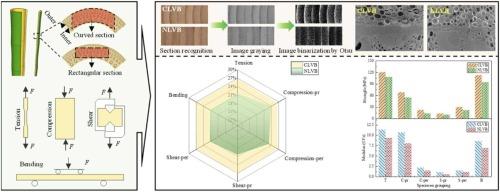Industrial Crops and Products ( IF 5.6 ) Pub Date : 2024-07-23 , DOI: 10.1016/j.indcrop.2024.119290 Dongpo Zhang , Liting Yan , Xinmiao Meng , Yousef Yahya Ali Sewar , Zhancheng Zhang , Ying Gao

|
Laminated veneer bamboo is a green and sustainable building material with better mechanical properties and lower discreteness than raw bamboo. Normal laminated veneer bamboo (NLVB) is usually made of flat-sawn bamboo strips, which needs to slice the curved cross-sectional bamboo strips into rectangular section. Nevertheless, the outer bamboo wall with rich vascular bundles is cut off, reducing the mechanical properties of laminated veneer bamboo. In this regard, a novel curved laminated veneer bamboo (CLVB), directly using curved cross-sectional bamboo strips, was investigated in this work. The failure modes, stress-strain relationships and load-displacement curves of CLVB material were studied and compared with NLVB material through tensile, compressive, shear and bending tests. Otsu algorithm was used to identify the proportion of vascular bundles. In addition, the microscopic morphology of the adhesive layer and vascular bundle was observed by scanning electron microscope (SEM). Finally, the energy consumption of the specimen was calculated to compare the differences of large deformation in bending test. The results showed that the CLVB and NLVB exhibited similar failure modes in tensile, shear and bending tests, but had different failure modes in compressive test. It was demonstrated that the CLVB showed significant enhancements in the strength and modulus when compared to the NLVB. Specifically, the proportion of cross-sectional vascular bundles in the CLVB was 1.22 times larger than that of the NLVB, contributing to the better mechanical performance of fiber-loaded specimens. In addition, the CLVB had superior bonding performance with a continuous and obvious adhesive layer in the SEM observation, while the adhesive layer of NLVB was discontinuous and irregular. Compared with CLVB, NLVB consumed more energy consumption due to the extra fiber dissociation of bending specimens. In short, CLVB performed better mechanical properties, showing its great potential as an alternative material to engineered bamboo.
中文翻译:

使用弯曲截面条的新型层压单板竹的机械性能
层压单板竹是一种绿色、可持续的建筑材料,与原竹相比,具有更好的机械性能和更低的离散性。普通层压单板竹(NLVB)通常由平锯竹条制成,需要将弯曲横截面的竹条切成矩形截面。然而,具有丰富维管束的外竹壁被切断,降低了层压单板竹的力学性能。在这方面,本工作研究了一种直接使用弯曲横截面竹条的新型弯曲层压单板竹材(CLVB)。通过拉伸、压缩、剪切和弯曲试验,研究了CLVB材料的失效模式、应力应变关系和载荷位移曲线,并与NLVB材料进行了比较。采用Otsu算法识别维管束比例。此外,通过扫描电子显微镜(SEM)观察粘合层和维管束的微观形貌。最后计算试件的能量消耗,比较弯曲试验中大变形的差异。结果表明,CLVB和NLVB在拉伸、剪切和弯曲试验中表现出相似的破坏模式,但在压缩试验中表现出不同的破坏模式。结果表明,与 NLVB 相比,CLVB 在强度和模量方面表现出显着增强。具体而言,CLVB中横截面维管束的比例是NLVB的1.22倍,有助于纤维加载样本更好的力学性能。此外,在SEM观察中,CLVB具有优异的粘合性能,具有连续且明显的粘合层,而NLVB的粘合层是不连续且不规则的。 与CLVB相比,NLVB由于弯曲试样的额外纤维解离而消耗更多的能量。简而言之,CLVB 具有更好的机械性能,显示出其作为工程竹替代材料的巨大潜力。












































 京公网安备 11010802027423号
京公网安备 11010802027423号